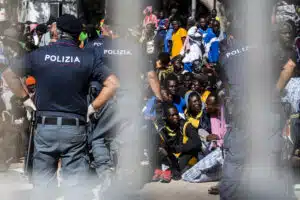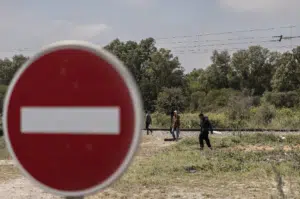Brussels – The European Parliament’s Committee on Civil Liberties, Justice, and Home Affairs (LIBE) MEPs applaud the approval of the 10 files of the new Migration and Asylum Pact. But the only ones who can rejoice are the governments of the 27 member countries –and not even all of them -that managed to push through not only their own negotiating mandates in almost their entirety during the trialogues but also changes that did not appear in the final texts agreed with negotiators of the European Parliament. The only one to take responsibility for summing up the contradiction at the LIBE committee meeting today (Feb. 14) was Damien Carême (Greens/Ale): “I would like to rise against the modality of the negotiations on the Migration and Asylum Pact, there was a total lack of transparency up to the last minute,” which represents “a slap in the face of democracy. W e caved in before the Council and this will cause damage” to the Union’s reception system for incoming migrants.
 In contrast, how the Council co-legislators handled the negotiations did not provoke any reaction in the European Parliament. As it was necessary to finalize the continent’s migration and asylum management legislation before the end of the legislative term – not to go to the June European elections with a failure after five years of negotiations – MEPs accepted virtually everything that the 27 governments imposed, leading up to the interim political understanding at the end of December 2023 and giving up almost all of the negotiating mandates approved last year (that even then were not particularly ambitious). In addition, in an unusual procedural deviation, last Thursday (Feb. 8), the Committee of Permanent Representatives (COREPER) approved the agreement on the new EU legislation, introducing two splits of the same number of Regulations – the amendment of the Regulation to facilitate screening (in addition to the Screening Regulation) and the Regulation establishing a return procedure at the border (in addition to the Regulation on asylum procedures) – and amendments to texts that were not agreed with the European Parliament.
In contrast, how the Council co-legislators handled the negotiations did not provoke any reaction in the European Parliament. As it was necessary to finalize the continent’s migration and asylum management legislation before the end of the legislative term – not to go to the June European elections with a failure after five years of negotiations – MEPs accepted virtually everything that the 27 governments imposed, leading up to the interim political understanding at the end of December 2023 and giving up almost all of the negotiating mandates approved last year (that even then were not particularly ambitious). In addition, in an unusual procedural deviation, last Thursday (Feb. 8), the Committee of Permanent Representatives (COREPER) approved the agreement on the new EU legislation, introducing two splits of the same number of Regulations – the amendment of the Regulation to facilitate screening (in addition to the Screening Regulation) and the Regulation establishing a return procedure at the border (in addition to the Regulation on asylum procedures) – and amendments to texts that were not agreed with the European Parliament.
“The points obtained at the December trialogues do not appear in the text drafted in the final version we received only recently,” French MEP Carême complained before the vote in the LIBE Committee, bringing the example of a text he followed closely as rapporteur for the Greens/Ale Group, the Regulation for the Management of Asylum and Migration (Ramm): “We had agreed to allow appeals against the denial of certain return decisions under the Dublin Regulation, and this does not appear in the final text.” Unscathed, however, is the broad majority, considering that almost all texts passed with at least 40 out of 67 votes in favor – that will now push the Migration and Asylum Pact through plenary without any particular difficulty. As sources inside the EU Parliament say, the final vote should be in the second session in April (between April 22 and 25, the last of this legislature).
The basis of the Migration and Asylum Pact
The new Migration and Asylum Pact system is based on the relationship between solidarity and responsibility in managing migrants among the 27 Member States. The former concept permeates the Regulation for the Management of Asylum and Migration (RAMM), which in no way overrides the cardinal principle of the 2013 Dublin Regulation, namely that the task of examining the asylum claim of a person who enters the EU territory irregularly lies with the first point of entry. Countries like Italy, Greece, Malta, Cyprus, and Spain will be responsible for applications. Other member states that want to ‘Dublin’ (i.e., extradite) these migrants – including minors and those applying for reunification with siblings – will simply have to send a notification, no longer a reciprocal due process request with the agreement of the country of first arrival as is the case today. After the Regulation enters into force – 24 months after its publication in the EU Official Journal – the now famous mandatory solidarity mechanism for all 27 Member States (based on GDP and population) will be introduced, which equalizes three forms of solidarity: relocations of migrants, financial contributions, or support to third countries. Contributions to member countries can be directed to reception systems and funding fixed and mobile border facilities through the Border and Visa Management Instrument (BMVI) and the Asylum, Migration, and Integration Fund (AMIF). There is no mandatory relocation for migrants disembarked after search and rescue operations at sea, and for those under the RAMM procedure, there is no legal representation, only counseling.
The concept of accountability is, in particular, related to the Asylum Procedures Regulation (APR), which increases only those provided for countries of first entry. It will automatically apply in case of risks related to security threats, including unaccompanied minors, “deception of authorities,” or if the migrant person comes from a country with a recognition rate of less than 20 percent. Border procedures will provide de facto detention, with no exemptions even for families with children under 12, nor legal representation, nor a stay for appeals against most decisions (except for inadmissibility of those based on the concept of “safe third country” and for unaccompanied minors). Crucial to this Regulation is the “Safe Third Country” concept, for which both an EU list and national lists are provided to justify and expedite rapid returns out of the Union unless there are links of the person to the state in question precluding their safety. New accountability obligations include completing the examination of an asylum application through the border procedure within six months (APR) but also extending the period of responsibility for handling applications for 20 months and keeping at 12 months that for search and rescue operations at sea (RAMM). The annual ceiling for border procedures is 30,000 people, determined based on a formula that considers the number of irregular border crossings and expulsions in the previous three years.
What happens when migrant people arrive
Once migrants arrive at the Union’s borders, the Regulation on Screening of the Migration and Asylum Pact will provide a 7-day detention procedure for the division between regular (RAMM) or expedited (APR) procedures to process asylum claims. Since the so-called ‘fiction of non-entry’ remains -that is, anyone screened in a special center will not be considered legally on the territory of the member state and, therefore, of the EU – in fact, migrants will be detained as they will have to remain at the disposal of authorities without the possibility of entering national soil. Some guarantees include the possibility for applicants to have access to a copy of the screening form and the preservation of the “relevant rules on detention” set out in the 2008 Return Directive (the revision contained in the Migration and Asylum Pact is the only dossier that is certain to fail). The monitoring mechanism, however, which does not necessarily include NGOs but can do so at the discretion of States, does not apply to border surveillance activities (with a normalization of racial profiling). If the state recognizes a security threat, it can grant national authorities direct access to all data on the person in all databases.

Concerning databases, according to the Eurodac Regulation, all migrant persons benefiting from temporary protection from the age of 6 years will have to accept submitting their biometric data, even though under the General Data Protection Regulation (GDPR), the processing is lawful only if the minor is at least 16. Greater data access for national authorities includes collecting photographic data of faces, effectively giving the green light to mass surveillance of people arriving on EU soil. Security alerts will be entered into the Eurodac database during the screening process and border procedures will include a whole range of new categories – such as irregular border crossing – also through the revision of the Entry and Exit System Review Regulation.
What happens in a crisis
One of the most controversial items in the Migration and Asylum Pact is the Regulation for Crises, Instrumentality, and Force Majeure, which deals with times when there is an exceptional or unexpected “mass arrival of people,” including after disembarkation after a search and rescue operation at sea. The Council’s negotiating position passed, which led to the inclusion of instrumentality (a Regulation that was initially a stand-alone and on which Parliament had not given the OK) for crises and force majeure in cases where “a hostile third country or non-state actor encourages or facilitates the movement of third-country nationals and stateless persons” towards the EU external borders “with the aim of destabilizing the Union or a Member State” by putting “the essential functions of a Member State at risk.” NGOs are excluded from this definition but only if they can demonstrate that their actions (at sea and otherwise) do not aim to destabilize, with clear risks of repercussions for the criminalization of solidarity.

There will be no compulsory relocations of migrants between member countries in crises but the application of the same three modes of solidarity as in the RAMM Regulation (relocations, financial contributions, or support to third countries). Instead, some scenarios will trigger derogations to the overall migration and asylum management system: the recognition rate threshold for which people can be admitted to border procedures (under the APR Regulation at 20 percent) will be 50 percent in force majeure situations, 60/70 percent in crises, and 100 percent in instrumentality situations. In this case, from the border procedures – the duration of which can be extended by an additional six weeks (compared to the 9 months in Apr) – families with children under 12 are not excluded.







